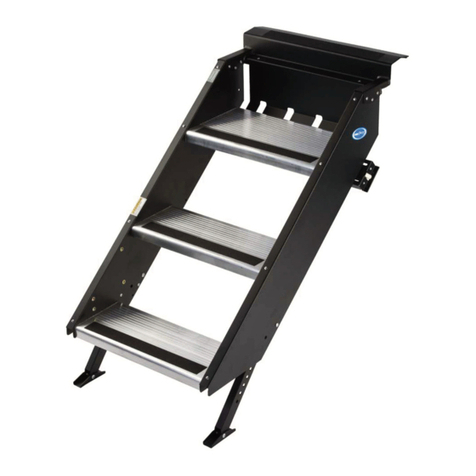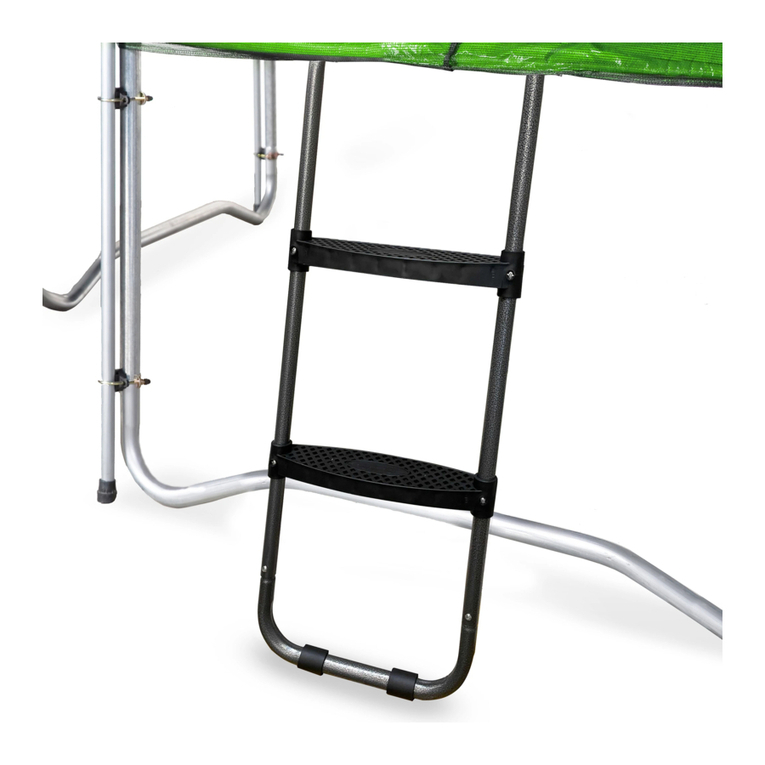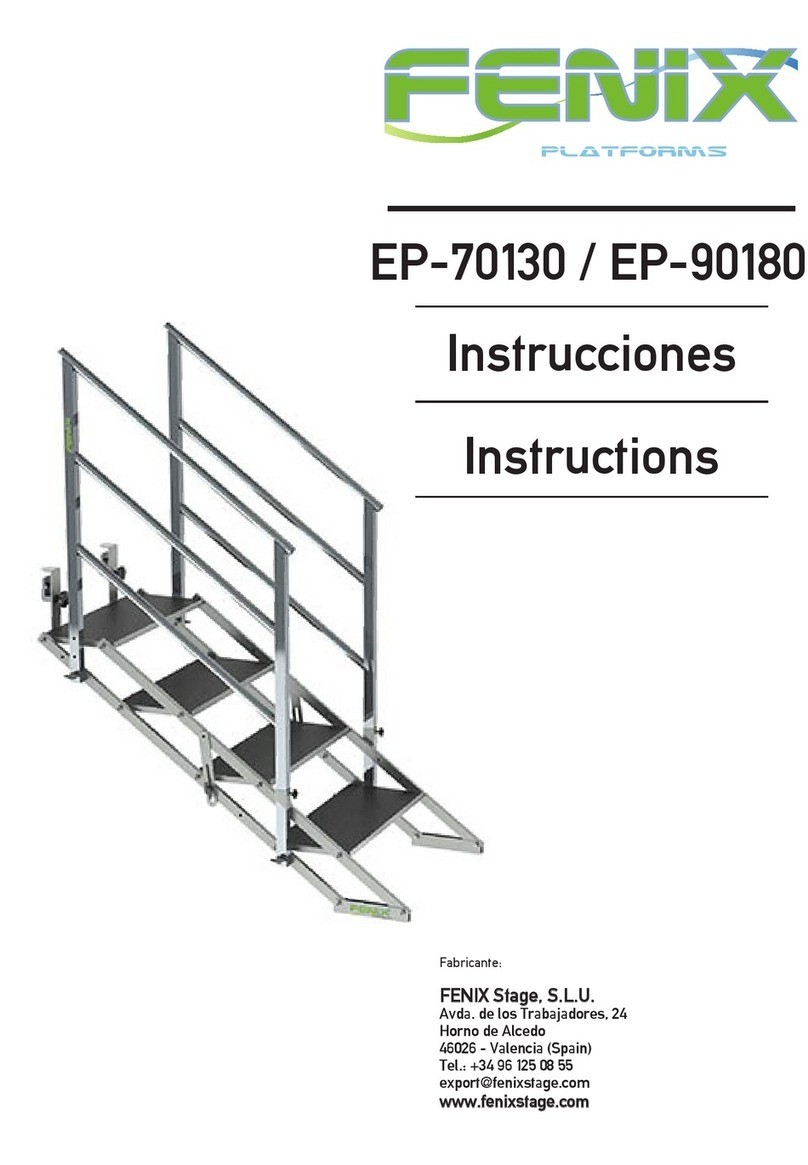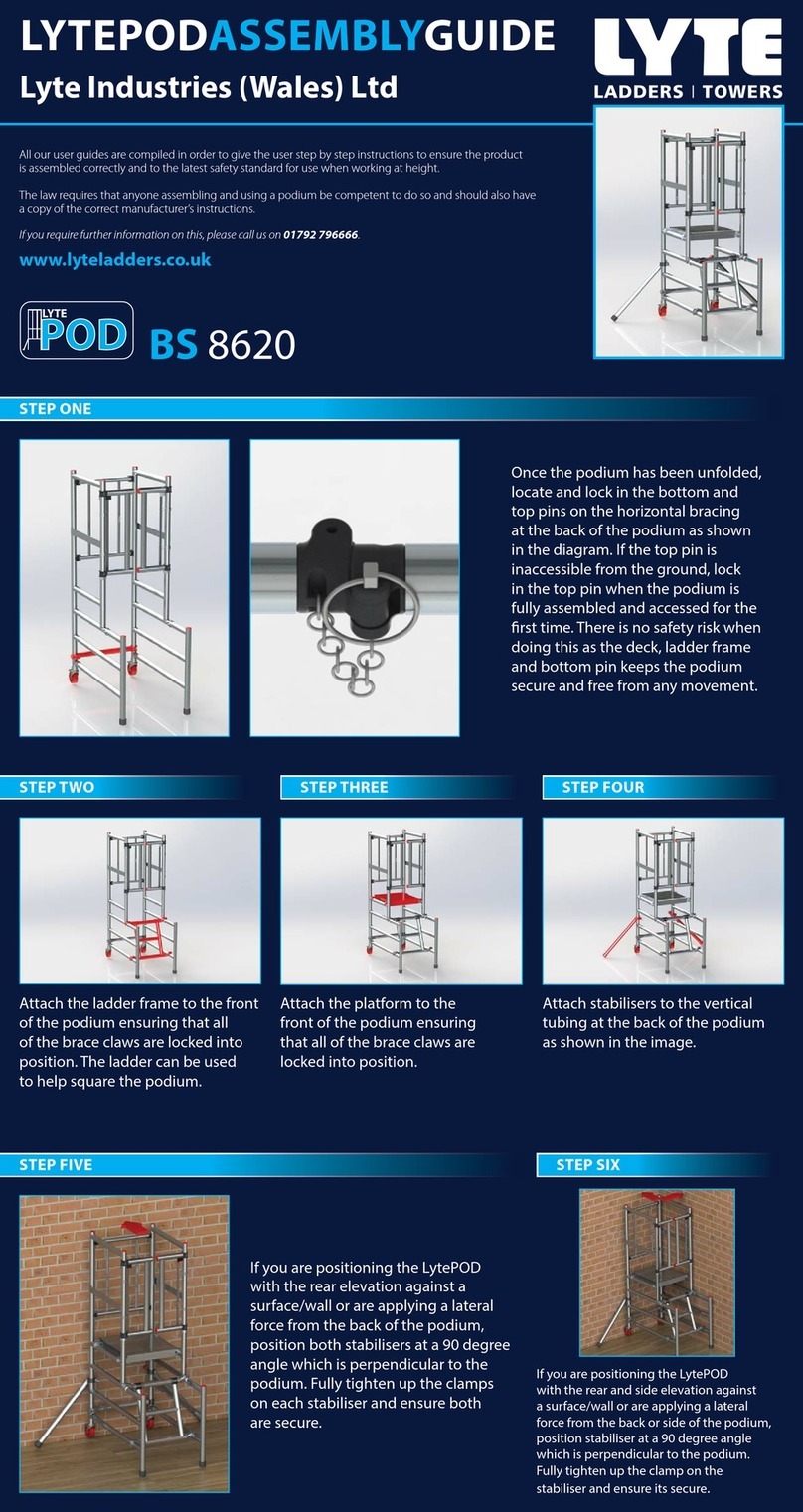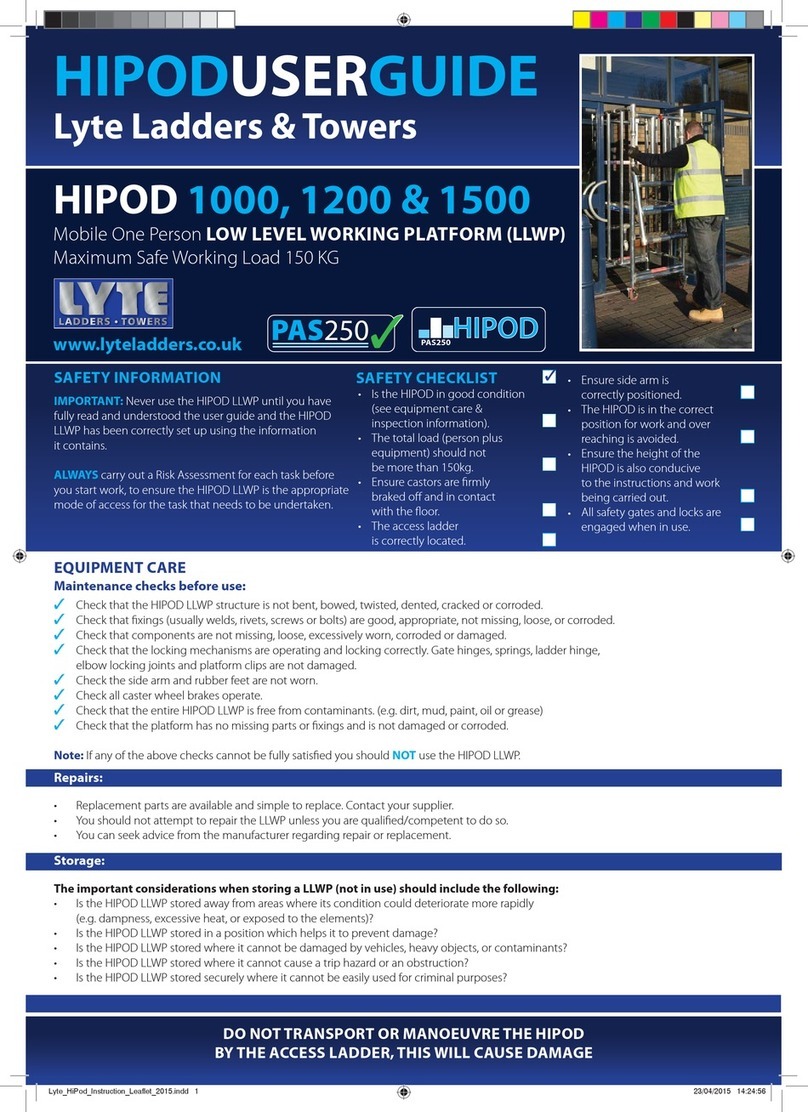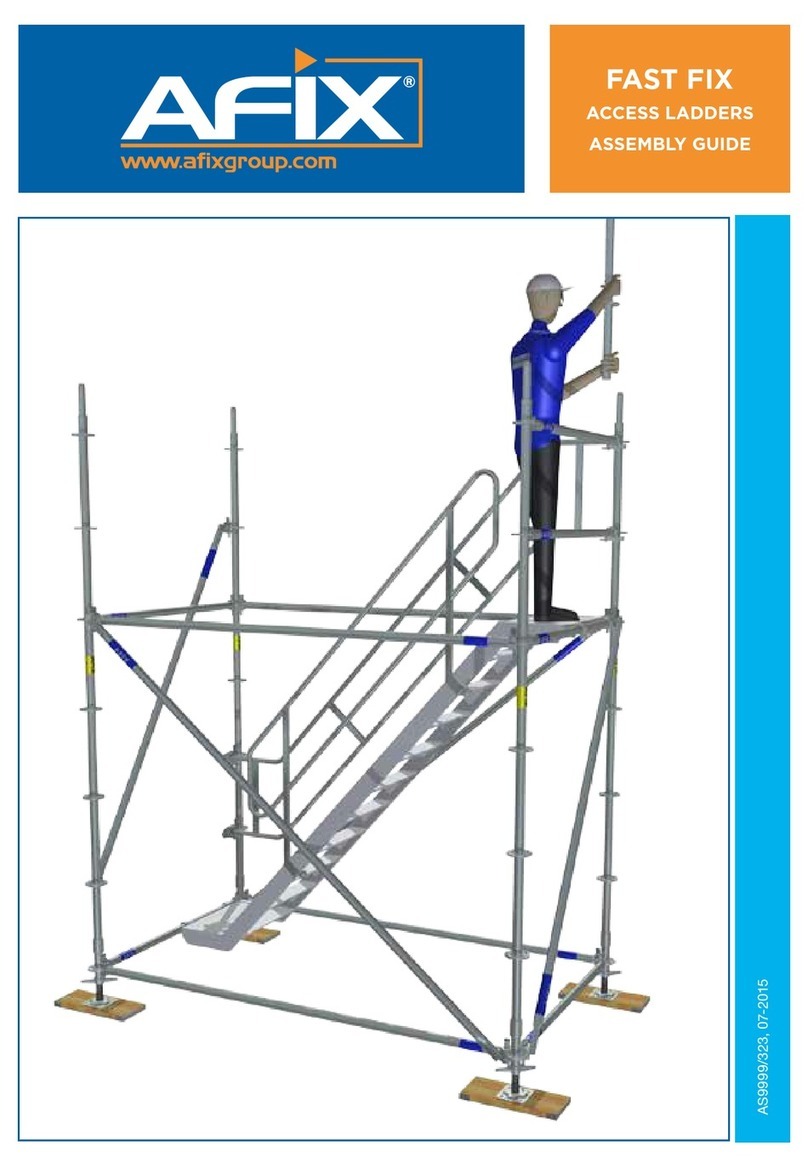DIVERSIFIED SJP-008 User manual

Industry Type:
All
Initial Issue Date:
August 3, 2018
Revision No:
Safe Job Procedure –Portable Ladders SJP-008
Preparation: Safety Specialist
Approval Authority: Senior Management
Issuing Dept: Safety
Controlled by:
Safety Specialist
Revised:
February 21, 2019
Approved by:
Senior Management
Path:
P:\Corporate\Safety Docs\Safe Job Procedures (SJP's)
Page 1 of 8
Description of Work:
Use of portable ladders
Potential Hazards:
Fall from >2m
Manual handling.
Personal Protective Equipment (PPE) Required
Gloves
Face Masks
Eye
Protection
Welding
Mask
Appropriate
Footwear
Hearing
Protection
Protective
Clothing
GENERAL:
To ensure that Diversified Staffing employees are protected from the hazards when working with/around
ladders.
PROTECTIVE MECHANISMS:
Personal Protective Equipment (PPE) - Part 18 OHS Code
OHS Legislation: Section 2(d) Act
to ensure that all workers have
(i) the right to be informed of work site hazards and the means to eliminate or control those
hazards,
(ii)the right to meaningful participation in health and safety activities pertaining to their work
and work site, including the ability to express health and safety concerns,
(iii) the right to refuse dangerous work
Training
Manufacturers Specifications
Emergency Response Plan (ERP)
Hazard Assessment
SUPERVISOR RESPONSIBILITY:
To facilitate and/or provide proper instruction to their workers on protection requirements
Selection of Equipment
Equipment Set-up
Hazard Assessment
Work Site Inspection

Industry Type:
All
Initial Issue Date:
August 3, 2018
Revision No:
Safe Job Procedure –Portable Ladders SJP-008
Preparation: Safety Specialist
Approval Authority: Senior Management
Issuing Dept: Safety
Controlled by:
Safety Specialist
Revised:
February 21, 2019
Approved by:
Senior Management
Path:
P:\Corporate\Safety Docs\Safe Job Procedures (SJP's)
Page 2 of 8
Safe Work Procedure Checklist:
1. Pre-operation:
Ladder is rated as ‘industrial’ with a load rating of at least 120kg
Ladder is fit for the task i.e use of fibre glass ladder for electrical work
Establish an exclusion zone beneath the area where overhead work is to be undertaken
Ladder is free from defects or damage before use
Consider whether a second person is needed to assist in securing the ladder
Ladder is positioned on a firm, level and non-slip surface
Ladder should be in the fully opened position with spreader fully engaged
The ladder must be firmly and evenly supported at the top (e.g. lashed, ladder support device)
2. Operation:
Check for overhead hazard prior to ascending ladder
Maintain three points of contact on the ladder whilst undertaking work
Always have two free hands to ascend and descend the ladder
“Highest rung on the ladder that you can stand on is clearly labelled. If the rung is not labelled, feet
should be no higher than the second rung from the top plate
“A” frame ladders are not to be used to access the roof
Undertake work facing the ladder
Do not use any power tools designed to be operated with two hands
Work within an arm’s reach to avoid falling sideways
Do not leave ladder unattended
3. Post-operation:
Store ladder on hooks at waist height
USE:
Prior to using a ladder, the employer or volunteer must ensure they do not exceed the weight capacity of
the ladder.
Ladders must be of sufficient height to perform the work. Standing on the step second top step, or
higher, of a step ladder to perform a task is prohibited. Keep your centre of gravity between the side
rails. Keep both feet on the ladder and/or step stool.
Ladders must be of sufficient height to perform the work; standing on the second top step or higher of a
step ladder to perform a task is prohibited. Keep your centre of gravity between the side rails. Keep both
feet on the ladder and/or step stool.
Ensure appropriate footwear and that footwear is free of anything slippery. Appropriate footwear for
ladder safety includes a closed shoe (toe and heel), with no to low heel that D.55 provides good stability.
- To climb a ladder, face the ladder and use both hands when going up or down, and maintain a firm
grip. Always keep a three (3) point contact (two (2) hands and a foot, or two (2) feet and a hand) on the
ladder when climbing. Keep your body near the middle of the step and don’t over-reach upwards or
sideways when on the ladder.
Place a step ladder at right angles to the work, with either the front or back of the steps facing the work.
Do not move a ladder horizontally while workers are on it.
Ensure to dismount the ladder before moving it. Dismount a ladder from the bottom rung; don’t jump
from a step ladder or slide down a step ladder.

Industry Type:
All
Initial Issue Date:
August 3, 2018
Revision No:
Safe Job Procedure –Portable Ladders SJP-008
Preparation: Safety Specialist
Approval Authority: Senior Management
Issuing Dept: Safety
Controlled by:
Safety Specialist
Revised:
February 21, 2019
Approved by:
Senior Management
Path:
P:\Corporate\Safety Docs\Safe Job Procedures (SJP's)
Page 3 of 8
LADDER MAINTENANCE:
Aluminium, fiberglass and metal ladders should be cleaned with soap and water, as needed.
Wooden ladders should be cleaned with a mild soap and water, and then dried.
Note: Wooden ladders that have been painted shall be removed from service.
STORAGE AND MOVING LADDERS:
Step ladders must always be secured to a wall or affixed structure, whether they are stored horizontally
or vertically. Horizontal storage either on the floor or hung on the wall must be supported at 4 to 5 foot
intervals; this is the same requirement for vertical storage. Step stools may be collapsed when not in
use.
Ladders should not be stored in areas where there is excessive heat or dampness. Also, it is best to
store ladders away from high traffic areas - people.
When moving a ladder, collapse the ladder, hold the middle side rail and tip slightly forward, watching
for overhead hazards and hazards at both ends.
LADDER PRECAUTIONS:
To avoid accidents with portable ladders:
Select the right ladder for the job situation; use the ladder as it was designed to be used; do not
overload a ladder (ie. do not put more weight on a ladder than it is designed to hold)
Step ladders cannot be used as straight ladders
Step ladders are designed for one person only
Before use, inspect the condition of the ladder; do not use a ladder with damaged parts that affect the
strength of the ladder; do not alter the structure of the ladder
Before use, inspect the job-site for overhead wires and obstructions
Before use ensure the stability of the base of the ladder; base to be placed on a level, non-slippery solid
surface. Remove material and debris away from the base of the ladder
Wooden ladders should not be painted
Avoid pushing or pulling step ladders from the side
Do not overload a ladder beyond its weight capacity
Do not leave ladders that are set-up unattended
Do not climb the back of a step ladder
Clean the soles of your footwear before climbing the ladder
Do not work on ladders when feeling weak, sick, or dizzy or when taking medication that may cause
drowsiness
Do not work on ladders covered with snow, ice, or other slippery materials
Do not work on ladders in bad weather or high winds
Do not use ladders, boxes, barrels, or other makeshift materials to raise your work height
Step ladders must be tall enough to perform the necessary work
NOTE:
All PPE must be inspected prior to use.
All equipment must be inspected prior to use.

Industry Type:
All
Initial Issue Date:
August 3, 2018
Revision No:
Safe Job Procedure –Portable Ladders SJP-008
Preparation: Safety Specialist
Approval Authority: Senior Management
Issuing Dept: Safety
Controlled by:
Safety Specialist
Revised:
February 21, 2019
Approved by:
Senior Management
Path:
P:\Corporate\Safety Docs\Safe Job Procedures (SJP's)
Page 4 of 8
*The information contained within this document does not take precedence over Occupational Health
and Safety legislation. All employees should be familiar with the Occupational Health and Safety Act and
the Regulations.
EXTENSION LADDERS:
Extension ladders usually have two sections that operate in brackets or guides that allow for the ladder to be
used at adjustable lengths. Extension ladders are not self-supporting and require a stable structure that can
withstand the intended load.
What should you do to safely secure extension ladders?
Place ladders on a firm, level surface and ensure the footing is secure.
Erect extension ladders so that the upper section rests on (e.g., in front of) the bottom section. This
placement means the bottom section "faces" a wall or other supporting surface (see figures below).
Place the ladder feet so that the horizontal distance between the feet and the top support is 1/4 of the
working length of the ladder. The ladder will be leaning at a 75 degree angle from the ground.
Raise and lower ladders from the ground. Ensure that locking ladder hooks are secure before climbing.
For access to an elevated work surface, erect ladders so that a minimum of 1 m (3 ft) extends above a
landing platform. Tie the top at support points.
Use care when getting on and or off the ladder at the top or bottom in order to avoid tipping the ladder
over sideways or causing the ladder base to slide.
Brace or tie off the ladder near the base. If there is no structure to tie off to, use a stake in the ground.
Leave all tie-off devices in place until they must be removed before taking the ladder down.
Maintain the minimum overlap of sections as shown on a ladder label. Refer to safety regulations.
Set up barricades and warning signs when using a ladder in a doorway or passageway.
Note: When working 3 metres (10 feet) or more above ground, wear a safety belt or harness with the lanyard
tied appropriately to the structure. Make sure that you follow working at heights training that includes how to
use fall protection devices safely.

Industry Type:
All
Initial Issue Date:
August 3, 2018
Revision No:
Safe Job Procedure –Portable Ladders SJP-008
Preparation: Safety Specialist
Approval Authority: Senior Management
Issuing Dept: Safety
Controlled by:
Safety Specialist
Revised:
February 21, 2019
Approved by:
Senior Management
Path:
P:\Corporate\Safety Docs\Safe Job Procedures (SJP's)
Page 5 of 8
What should you avoid when using extension ladders?
Do not use ladders near power lines. Keep ladders and other tools at least 10 feet away from power
lines.
Do not use ladders unless they have been inspected by a trained or competent person.
Do not set up or take a ladder down when it is extended.
Do not overextend. Maintain minimum overlap of sections.
Do not climb higher than the fourth rung from the top of a ladder.
Do not use ladders on ice, snow or other slippery surfaces without securing ladders' feet.
Do not extend top section of a ladder from above or by "bouncing" on a ladder.
Do not leave ladders unattended.
What should you do to avoid overexertion while setting up an extension ladder?
When setting up an extension ladder, use the following method to avoid straining muscles or losing control of a
ladder. With ladders weighing more than 25 kg (55 lb), or where conditions complicate the task, have two
persons set up a ladder, step by step, as follows:
Lay a ladder on the ground close to intended location.
Brace ladder base using helpers' feet.
Grasp the top rung with both hands, raise the top end over your head and walk toward the base of a
ladder. Grasp the centre of the rungs to maintain stability.
Move the erect ladder to the desired location. Lean it forward against the resting point.
One person can erect a short ladder, step by step as follows:
Place the bottom of a ladder firmly against the base of a building or stationary object.
Lift the top of ladder, and pull upwards to raise a ladder to a vertical position.

Industry Type:
All
Initial Issue Date:
August 3, 2018
Revision No:
Safe Job Procedure –Portable Ladders SJP-008
Preparation: Safety Specialist
Approval Authority: Senior Management
Issuing Dept: Safety
Controlled by:
Safety Specialist
Revised:
February 21, 2019
Approved by:
Senior Management
Path:
P:\Corporate\Safety Docs\Safe Job Procedures (SJP's)
Page 6 of 8
Transfer a ladder to its required position when it is erect.
Keep a ladder upright and close to the body with a firm grip.
One person can erect a short ladder, step by step as follows:
Place the bottom of a ladder firmly against the base of a building or stationary object.
Lift the top of ladder, and pull upwards to raise a ladder to a vertical position.
Transfer a ladder to its required position when it is erect.
Keep a ladder upright and close to the body with a firm grip.
The method for lowering any ladder is the reverse procedure of erecting it.

Industry Type:
All
Initial Issue Date:
August 3, 2018
Revision No:
Safe Job Procedure –Portable Ladders SJP-008
Preparation: Safety Specialist
Approval Authority: Senior Management
Issuing Dept: Safety
Controlled by:
Safety Specialist
Revised:
February 21, 2019
Approved by:
Senior Management
Path:
P:\Corporate\Safety Docs\Safe Job Procedures (SJP's)
Page 7 of 8
STEP LADDERS:
What should you do when using a stepladder?
Check the load rating that is marked on the stepladder. The rating should cover the person’s weight and
the weight of tools that will be used.
Use a stepladder that is about 1 m (3 ft) shorter than the highest point you have to reach. This gives a
wider, more stable base and places shelf at a convenient working height.
Do not use a ladder that has cracks, lose or corroded rivets, defective braces, or parts (including the slip
resistant feet) that are in poor condition. Make sure it is free of grease or oil or other slippery
substances.
Open the stepladder spreaders and shelf fully and lock the braces.
Check stability. Ensure that all ladder feet are on a firm, level and non-slippery surface.
Place a stepladder at right angles to the work, with either the front or back of the steps facing the work.
Keep the stepladder close to the work.
Avoid pushing or pulling stepladders from the side. Repeated sideways movement can make ladders
wobbly since they are weaker or less stable in those directions.
Face the stepladder when climbing up or down. Keep your body centered between side rails. You have
climbed too high if your knees are above top of the stepladder or if you cannot maintain a handhold on
the ladder.
Maintain a firm grip. Use both hands when climbing.
What are step ladder ratings, and is there a maximum length for a step ladder?
The Canadian Standards Association (CSA) Standard Z11-12 recommends different lengths for different rating
(or grades) of step ladders.
Grade
Description of Grade
Maximum Length
1AA
Construction and industrial use; special duty with load rating of 170 kg (375
lbs)
3.6 m (12 ft)
1A
Construction and industrial use; extra heavy duty with load rating of 136 kg
(300 lbs)
6 m (20 ft)
1
Construction and industrial use; heavy duty with load rating of 113 kg (250 lbs)
6 m (20 ft)
2
Tradesmen and farm; medium duty with a load rating of 102 kg (225 lbs)
3.6 m (12 ft)
3
Household; light duty with load rating of 91 kg (200 lbs)
2 m (6.5 ft)

Industry Type:
All
Initial Issue Date:
August 3, 2018
Revision No:
Safe Job Procedure –Portable Ladders SJP-008
Preparation: Safety Specialist
Approval Authority: Senior Management
Issuing Dept: Safety
Controlled by:
Safety Specialist
Revised:
February 21, 2019
Approved by:
Senior Management
Path:
P:\Corporate\Safety Docs\Safe Job Procedures (SJP's)
Page 8 of 8
What should you avoid when using a stepladder?
Do not overreach. Move a stepladder when needed.
Do not "shift" or "walk" a stepladder when standing on it.
Do not stand, climb, or sit on the stepladder top or pail shelf.
Do not stand on or above the top two rungs or steps of the stepladder.
Do not overload. Stepladders are meant for one person.
Do not use a stepladder as a brace or as a support for a work platform or plank.
Do not climb a stepladder that is leaning against a wall. Use a straight ladder instead.
Do not use stepladders on slippery surfaces
Do not use stepladders on soft ground where one leg may sink farther into the ground than others.
Do not place stepladders on boxes, barrels, unstable bases, or on scaffolds to gain additional height.
Do not climb the back of a stepladder.
Do not push or pull stepladders sideways.
Do not use ladders in passageways, doorways, driveways or other locations where a person or vehicle
can hit it. Set up suitable barriers or lock doors shut.
Table of contents
Popular Ladder manuals by other brands

GÜNZBURGER STEIGTECHNIK
GÜNZBURGER STEIGTECHNIK 30299 instruction manual

Little Giant
Little Giant CAGE IAA User instructions
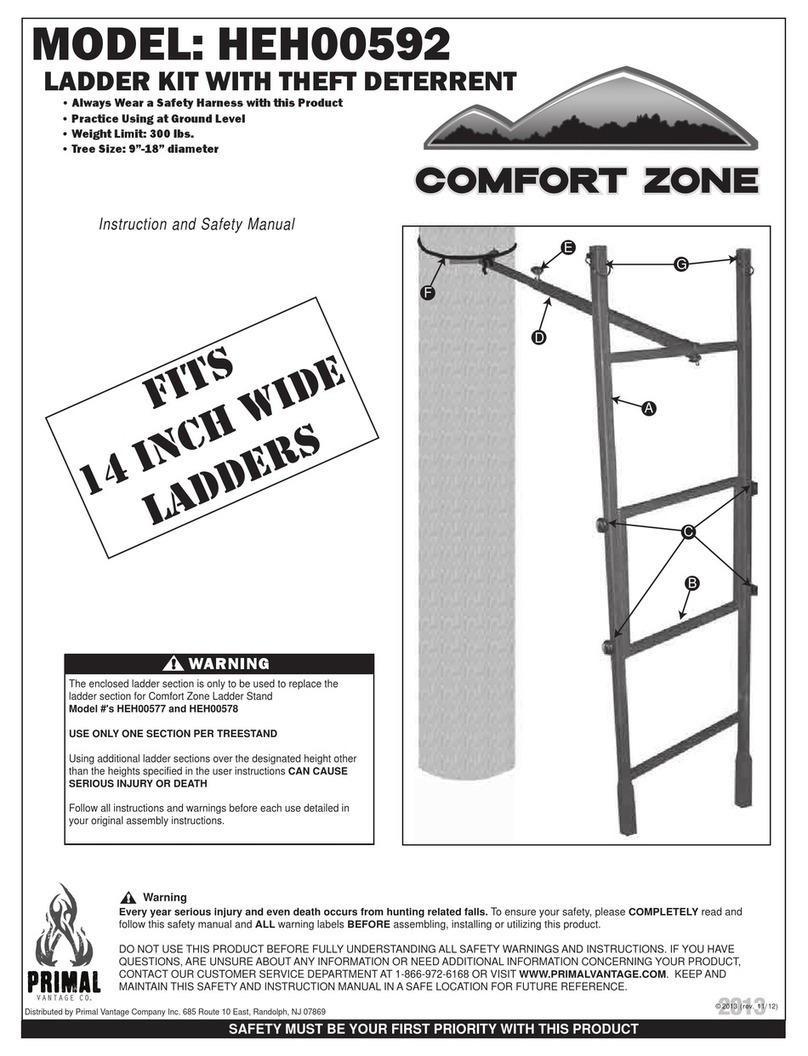
Primal
Primal HEH00592 Instruction and safety manual
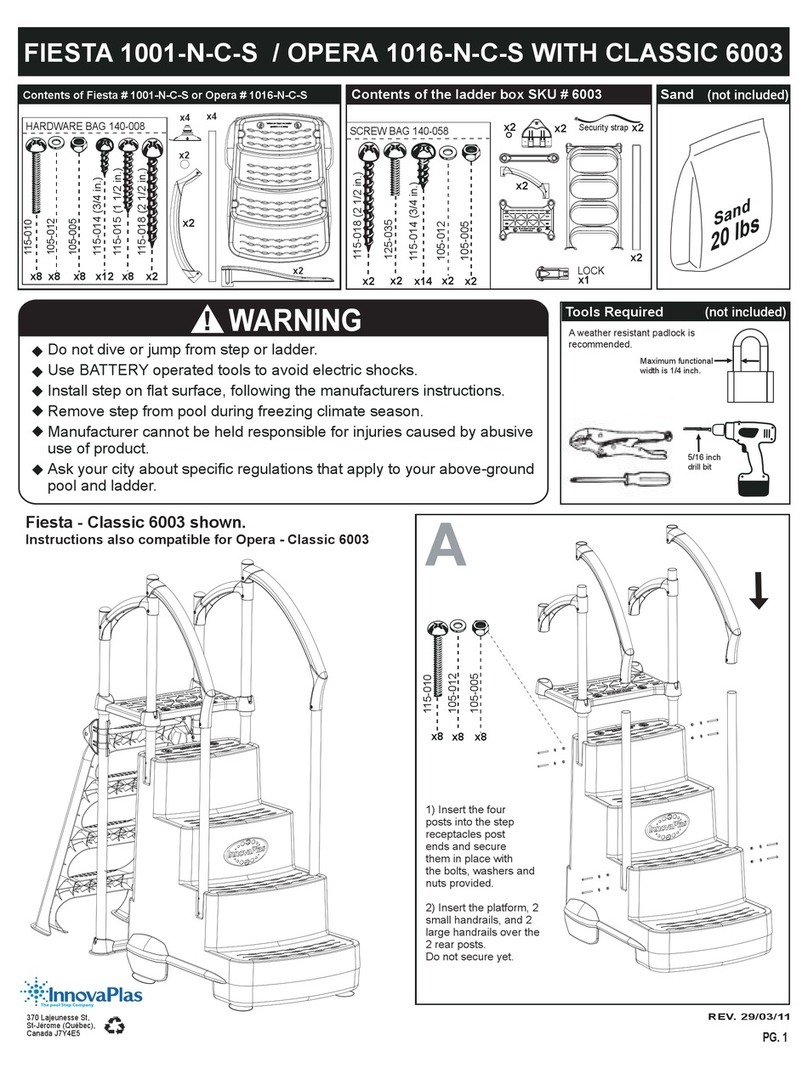
INNOVAPLAS
INNOVAPLAS FIESTA 1001-N-C-S Manufacturer's Instructions
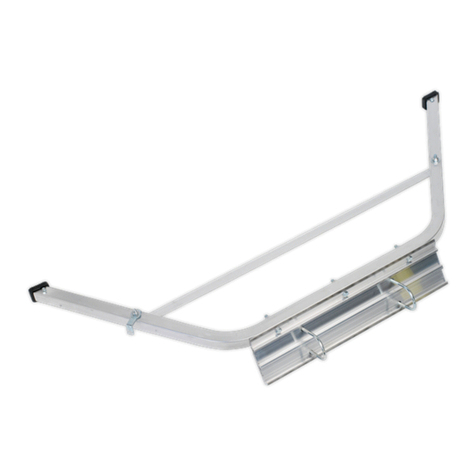
Sealey
Sealey LAD-002 instructions

Würth
Würth 0962 975 23 instructions
